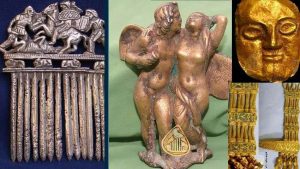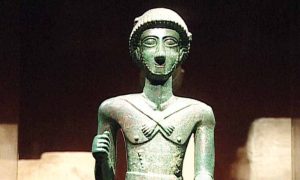Under Saudi and Emirati Patronage… Mercenary Gangs Plunder Yemen’s History and Assassinate Its Civilizational Heritage
The issue of smuggling Yemeni antiquities and selling them in European auctions ranks among the most egregious crimes against Yemen’s cultural and historical heritage, especially in light of the ongoing aggression since 2015. Various parties are implicated in these operations, ranging from local trafficking networks to certain officials within the mercenary government aligned with the Saudi-Emirati coalition.
Statistics on the Smuggling of Yemeni Antiquities
According to official reports, more than 13,000 Yemeni artifacts have been smuggled since 1994 to the present day, roughly 8,000 of which were taken during the period of the Saudi-Emirati aggression against Yemen. These items encompass statues, manuscripts, funerary stele, and stone and metal tools that date back to different historical epochs.
One investigative report documented 4,265 Yemeni artifacts offered in sixteen online auctions across six Western countries, distributed as follows:
-
United States: 2,167 pieces
-
Netherlands: 972 pieces
-
Israel: 501 pieces
-
United Kingdom: 421 pieces
-
France: 135 pieces
-
Germany: 69 pieces
These figures demonstrate the systematic targeting of Yemeni antiquities, particularly during the years of aggression.
The Role of the Mercenary Government and the Coalition in Smuggling Operations
Yemen’s Ministry of Culture and Tourism in Sanaa holds the mercenary government—and those behind it—responsible for the destruction of archaeological sites, the theft of artifacts, and their sale in global auctions. The ministry indicates that measures are currently being taken to recover all smuggled Yemeni pieces and to pursue and prosecute everyone involved in these crimes, both domestically and internationally.
Among the names implicated is the Minister of Information in the mercenary government, Muammar al-Eryani, who has been accused of trafficking Yemeni antiquities and historical manuscripts and selling them in European markets.
Notable Yemeni Artifacts Exhibited in Auctions
-
Rare Funerary Stele: Offered in an auction in Spain, this stele dates back approximately 2,100 to 2,800 years. Its carving depicts a human head with large, deeply incised eyes and clearly defined eyebrows.
-
15th-Century Manuscript: Sold at Sotheby’s for $845,000.
-
Bronze Statue: Dating from roughly the 1st century BCE to the 1st century CE, auctioned at Christie’s for $576,000.
Challenges and Future Prospects
Efforts to recover Yemen’s looted artifacts face significant obstacles, chief among them:
-
Collusion by Some Mercenary Government Officials: Their direct involvement in smuggling operations, in partnership with unscrupulous local mercenaries used to facilitate the theft and trafficking.
-
Security Vacuum in Areas Controlled by the Mercenary Government: This lax environment enables looting and smuggling, as well as a lack of coordination with international organizations such as UNESCO to reclaim stolen items.
Despite these challenges, Yemen’s Salvation Government in Sanaa continues—through its relevant agencies—to track and monitor the artifacts and to coordinate with counterpart authorities in countries where these items are exhibited, aiming to repatriate them to their homeland.
Aggression Against Antiquities… Aggression Against Identity
The plundering, smuggling, and auctioning of Yemeni artifacts cannot be separated from the comprehensive aggression waged by the Saudi-led coalition on Yemen since 2015. This campaign did not limit its objectives to destroying infrastructure, killing civilians, and besieging the Yemeni people; it also struck at Yemen’s rich cultural and civilizational heritage, which embodies the identity and soul that run deep through Yemeni history.
Investigations and firsthand accounts reveal that the smuggling of Yemeni antiquities was not a set of isolated or illicit transactions, but rather a coordinated project involving senior figures within the mercenary government allied with the coalition and Emirati and Saudi entities. Under the guise of “cultural investment” at times and “heritage preservation” at others, the reality on the ground exposes a systematic campaign to erase Yemen’s history and steal its symbols.
This overt collusion confirms that the assault on Yemen’s heritage was neither accidental nor merely a byproduct of wartime chaos. It formed part of a deliberate strategy to obliterate Yemen’s ancient identity and undermine the symbols of its civilization, which flourished thousands of years ago—spanning the kingdoms of Sabaʾ, Maʾīn, Ḥaḍramawt, and Ḥimyar. Those regions were once shining centers of culture within the Arabian Peninsula, while the territories belonging to the coalition states remained steeped in desert nomadism.
This multifaceted crime—an act of cultural aggression alongside military and economic aggression—exposes the deep-seated animosity that the coalition nations harbor toward Yemen’s storied past. It also reveals their relentless ambition to wipe away every reminder of the greatness of this land and the pride it has long instilled in peoples’ consciousness.
Hence, the battle to protect Yemen’s antiquities is no longer merely a cultural or legal endeavor; it has become a national and sovereign struggle against a colonial project intent on erasing Yemen’s collective memory and robbing it of its civilizational spirit. Consequently, it is a moral and patriotic imperative for official bodies, civil society, and international organizations to escalate efforts to recover what has been stolen from Yemen’s history and to document these crimes so that their perpetrators can be held accountable before international courts—regarded, above all, as crimes against human heritage and global civilization.




